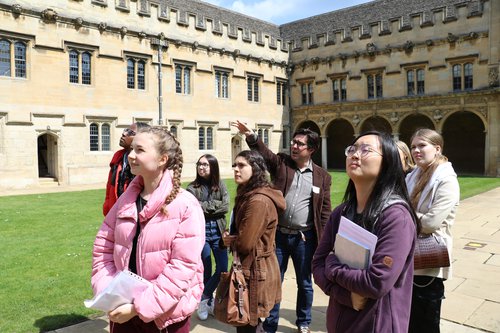Progress on access and admissions
I have had the privilege of chairing the Admissions Committee on behalf of the collegiate University as well as the working group developing major initiatives to enable Oxford to reach the stretching targets required by our regulator, the Office for Students. In essence, the challenge we confront is to ‘move the dial’ to increase the numbers of students from less advantaged backgrounds admitted to Oxford. To make the required step change, the University has launched a bridging programme, known as Opportunity Oxford (for the 2019 admissions round) and will develop a Foundation Year programme for 2021. You can read more about these initiatives at www.ox.ac.uk/opportunity.
 St. John’s College has long been
committed to widening access and I am grateful to Governing Body for their
support in this regard. In 2017, we launched Inspire, an outreach initiative to
encourage more applications from non-selective state school pupils. Building on
the success of this scheme, this year we launched Pre-GCSE Inspire, a sustained approach beginning in Year 9 which
aims to support pupils and teachers in our link schools through a programme of
events. Both initiatives have received generous philanthropic support to enable
the delivery of academic skills and cultural experiences for those who aspire
to elite universities. We are proud of what we are achieving and I am very
grateful for the hard work and commitment of the Access team.
St. John’s College has long been
committed to widening access and I am grateful to Governing Body for their
support in this regard. In 2017, we launched Inspire, an outreach initiative to
encourage more applications from non-selective state school pupils. Building on
the success of this scheme, this year we launched Pre-GCSE Inspire, a sustained approach beginning in Year 9 which
aims to support pupils and teachers in our link schools through a programme of
events. Both initiatives have received generous philanthropic support to enable
the delivery of academic skills and cultural experiences for those who aspire
to elite universities. We are proud of what we are achieving and I am very
grateful for the hard work and commitment of the Access team.
This week sees the publication of Oxford’s latest Annual Admissions Statistical Report. Headline figures remind us that admission to Oxford is highly competitive with more than half of applicants, and almost 90% of admitted students, achieving A*AA or better at A-level. Furthermore, the majority of Oxford’s students are from the UK and the probability of being offered a place is higher for such applicants than for those from abroad. In terms of the admission of students from less advantaged backgrounds, and from ethnic minorities, there has been a steady increase over the last five years in admission to Oxford but it is acknowledged in our Access and Participation Plan, that there is more to do.
 St. John’s is maintaining its
record of admitting students with the greatest potential, regardless of
background. The College’s statistics (aggregated for the period 2016–18) compare
favourably with the overall figures for the University, particularly in
relation to the proportion of students admitted from socio-economically
disadvantaged areas (St John’s 11.8%, University total 10%), of BME students (St
John’s 19.7%, University total 17.3%) and of state school pupils (St John’s 59.1%,
University total 58.9%).
St. John’s is maintaining its
record of admitting students with the greatest potential, regardless of
background. The College’s statistics (aggregated for the period 2016–18) compare
favourably with the overall figures for the University, particularly in
relation to the proportion of students admitted from socio-economically
disadvantaged areas (St John’s 11.8%, University total 10%), of BME students (St
John’s 19.7%, University total 17.3%) and of state school pupils (St John’s 59.1%,
University total 58.9%).
Professor Maggie Snowling, CBE FBA FMedSci
President